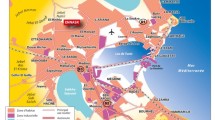Abstract
Antibiotic pollution in aquatic systems is a concern for human and environmental health. The concern is largely due to the global occurrence of antibiotic-resistant bacteria. From 2017 to 2018 in the NC Piedmont, 15 ion masses associated with antibiotics were detected in rural streams and groundwater. Four of these masses were confirmed to be antibiotics through target analysis (sulfamethoxazole, sulfamerazine, erythromycin, danofloxacin). Concentrations of antibiotics were as high as 1.8 μg/L. As a follow-up, antibiotic residues in urban streams sites in Greensboro, NC, USA, were investigated. Urban streams are heavily influenced by the dense populations surrounding them. In the fall, winter, and spring seasons, surface water was collected from eight sites along two urban streams. Sampling was conducted at streams sites above and below municipal hospitals and wastewater treatment facilities in the study area. At the conclusion of the survey, nine ion masses associated with antibiotics used in both human and veterinary medicine were detected from surface water collected. Three of the four antibiotics targeted in rural stream samples were detected and confirmed in urban stream samples (sulfamerazine, danofloxacin, and erythromycin). Detection frequencies of the three antibiotics ranged from 0 to 46%. Concentrations of each target antibiotic was as followed: SMX (0 to <10 ng/L), SMR (0 to <11 ng/L), DAN (0 to <20 ng/L), and ETM (0 to <15 ng/L). Each target antibiotic concentration was below our methods quantification limits. Our risk assessment analysis showed that the target antibiotics posed no risk to fish, daphnia, and green algae within this region of NC (RQ < 0.1). Compared to rural streams in this region of NC, antibiotic pollution is less prevalent in urban streams. The differences between urban and rural streams may be driven by the varying land use and suggest more research should be dedicated to monitoring these contaminants in rural areas of the United States.


Similar content being viewed by others
References
Grimm NB, Faeth SH, Golubiewski NE, Redman CL, Wu J, Bai X, et al. Global change and the ecology of cities. Science. 2008;319:756–60.
USEPA, 2008. Contaminants of Emerging Concern. n.d. [cited 2015 April 1]; Available from: http://water.epa.gov/scitech/cec/.
Liu J-L, Wong M-H. Pharmaceuticals and personal care products (PPCPs): a review on environmental contamination in China. Environ Int. 2013;59:208–24.
Massé DI, Saady NMC, Gilbert Y. Potential of biological processes to eliminate antibiotics in livestock manure: an overview. Animals. 2014;4(2):146–63.
Kolpin DW, Furlong ET, Meyer MT, Thurman EM, Zaugg SD, Barber LB, et al. Pharmaceuticals, hormones, and other organic wastewater contaminants in US streams, 1999–2000: A national reconnaissance. Environ Sci Technol. 2002;36(6):1202–11.
Michael I, Rizzo L, McArdell CS, Manaia CM, Merlin C, Schwartz T, et al. Urban wastewater treatment plants as hotspots for the release of antibiotics in the environment: a review. Water Res. 2013;47(3):957–95.
Al-Maadheed S, Goktepe I, Latiff ABA, Shomar B. Antibiotics in hospital effluent and domestic wastewater treatment plants in Doha, Qatar. Journal of Water Process Engineering. 2019;28:60–8.
Göbel A, Thomsen A, McArdell CS, Joss A, Giger W. Occurrence and sorption behavior of sulfonamides, macrolides, and trimethoprim in activated sludge treatment. Environ Sci Technol. 2005;39(11):3981–9.
Nakada N, Kiri K, Shinohara H, Harada A, Kuroda K, Takizawa S, et al. Evaluation of pharmaceuticals and personal care products as water-soluble molecular markers of sewage. Environ Sci Technol. 2008;42(17):6347–53.
Gibs J, Heckathorn HA, Meyer MT, Klapinski FR, Alebus M, Lippincott RL. Occurrence and partitioning of antibiotic compounds found in the water column and bottom sediments from a stream receiving two wastewater treatment plant effluents in northern New Jersey, 2008. Sci Total Environ. 2013;458:107–16.
Cha JM, Yang S, Carlson KH. Trace determination of β-lactam antibiotics in surface water and urban wastewater using liquid chromatography combined with electrospray tandem mass spectrometry. J Chromatogr A. 2006;1115(1–2):46–57.
He K, Soares AD, Adejumo H, McDiarmid M, Squibb K, Blaney L. Detection of a wide variety of human and veterinary fluoroquinolone antibiotics in municipal wastewater and wastewater-impacted surface water. J Pharm Biomed Anal. 2015;106:136–43.
Gray AD, Todd D, Hershey AE. The seasonal distribution and concentration of antibiotics in rural streams and drinking wells in the piedmont of North Carolina. Sci Total Environ. 2020;710:136286.
Boy-Roura M, Mas-Pla J, Petrovic M, Gros M, Soler D, Brusi D, et al. Towards the understanding of antibiotic occurrence and transport in groundwater: findings from the Baix Fluvià alluvial aquifer (NE Catalonia, Spain). Sci Total Environ. 2018;612:1387–406.
DeVries SL, Zhang P. Antibiotics and the terrestrial nitrogen cycle: a review. Current Pollution Reports. 2016;2(1):51–67.
Parker JK, McIntyre D, Noble RT. Characterizing fecal contamination in stormwater runoff in coastal North Carolina, USA. Water Res. 2010;44(14):4186–94.
Sauer EP, VandeWalle JL, Bootsma MJ, McLellan SL. Detection of the human specific Bacteroides genetic marker provides evidence of widespread sewage contamination of stormwater in the urban environment. Water Res. 2011;45(14):4081–91.
Rosi EJ, Bechtold HA, Snow D, Rojas M, Reisinger AJ, Kelly JJ. Urban stream microbial communities show resistance to pharmaceutical exposure. Ecosphere. 2018;9(1):e02041.
Marti E, Variatza E, Balcazar JL. The role of aquatic ecosystems as reservoirs of antibiotic resistance. Trends Microbiol. 2014;22(1):36–41.
Yang Y, Song W, Lin H, Wang W, Du L, Xing W. Antibiotics and antibiotic resistance genes in global lakes: a review and meta-analysis. Environ Int. 2018;116:60–73.
Bansal OP. Antibiotics in hospital effluents and their impact on the antibiotics resistant bacteria and remediation of the antibiotics: a review. Network Pharmacology. 2019;4(3–4):6–30.
O'neill, J. (2014). Antimicrobial Resistance. Tackling a Crisis for the Health and Wealth of Nations.
North Carolina Department of Environment and Natural Resources NCDENR, Division of Water Quality. 2005. Surface waters an wetlands standards, North Carolina Department of Environment and Natural Resources, NCDENR, Division of Water Quality, Raleigh, N.C.
Meyer JL, Pail LJ, Keith Taulbee W. Stream ecosystem function in urbanization landscape. Journal of the American Benthol Society. 2005;24(3):602–12.
Walsh CJ, Roy AH, Feminella JW, Cottingham PD, Groffman PM, Morgan RP. The urban stream syndrome: current knowledge and the search for a cure. J N Am Benthol Soc. 2005;24(3):706–23.
2019 US Census Bureau, https://www.census.gov/data/developers/data-sets/acs-5year.html
Blum PW, Hershey AE, Tsui MK, Hammerschmidt CR, Agather AM. Methylmercury and methane production potentials in North Carolina Piedmont stream sediments. Biogeochemistry. 2018;137(1–2):181–95.
Hurtaud-Pessel D, Jagadeshwar-Reddy T, Verdon E. Development of a new screening method for the detection of antibiotic residues in muscle tissues using liquid chromatography and high resolution mass spectrometry with a LC-LTQ-Orbitrap instrument. Food Additives & Contaminants: Part A. 2011;28(10):1340–51.
Pugajeva I, Rusko J, Perkons I, Lundanes E, Bartkevics V. Determination of pharmaceutical residues in wastewater using high performance liquid chromatography coupled to quadrupole-Orbitrap mass spectrometry. J Pharm Biomed Anal. 2017;133:64–74.
Baber N. International conference on harmonisation of technical requirements for registration of pharmaceuticals for human use (ICH). Br J Clin Pharmacol. 1994;37(5):401–4.
Shrivastava A, Gupta VB. Methods for the determination of limit of detection and limit of quantitation of the analytical methods. Chronicles of young scientists. 2011;2(1):21.
Verlicchi P, Al Aukidy M, Galletti A, Petrovic M, Barceló D. Hospital effluent: investigation of the concentrations and distribution of pharmaceuticals and environmental risk assessment. Sci Total Environ. 2012a;430:109–18. https://doi.org/10.1016/j.scitotenv.2012.04.055.
Verlicchi P, Al Aukidy M, Zambello E. Occurrence of pharmaceutical compounds in urban wastewater: removal, mass load and environmental risk after a secondary treatment-a review. Sci Total Environ. 2012b;429:123–55. https://doi.org/10.1016/j.scitotenv.2012.04.028.
Bradley PM, Journey CA, Button DT, Carlisle DM, Clark JM, Mahler BJ, et al. Metformin and other pharmaceuticals widespread in wadeable streams of the southeastern United States. Environmental Science & Technology Letters. 2016;3(6):243–9.
Robinson AA, Belden JB, Lydy MJ. Toxicity of fluoroquinolone antibiotics to aquatic organisms. Environmental Toxicology and Chemistry: An International Journal. 2005;24(2):423–30.
Payán MR, López MÁB, Fernández-Torres R, González JAO, Mochón MC. Hollow fiber-based liquid phase microextraction (HF-LPME) as a new approach for the HPLC determination of fluoroquinolones in biological and environmental matrices. J Pharm Biomed Anal. 2011;55(2):332–41.
“Pet Waste: Greensboro, NC.” Pet Waste | Greensboro, NC, City of Greensboro, 14 Mar. 2019, www.greensboro-nc.gov/departments/water-resources/stormwater-program/pet-waste.
Matsuoka, Sayaka. “Millions of Gallons of Untreated Sewage Released in Greensboro in 2018.” The NC Triad's Altweekly, 27 Feb. 2019, triad-city-beat.com/millions-of-gallons-of-untreated-sewage-released-in-greensboro-in-2018/.
Watkinson AJ, Murby EJ, Kolpin DW, Costanzo SD. The occurrence of antibiotics in an urban watershed: from wastewater to drinking water. Sci Total Environ. 2009;407(8):2711–23.
Peng X, Wang Z, Kuang W, Tan J, Li K. A preliminary study on the occurrence and behavior of sulfonamides, ofloxacin and chloramphenicol antimicrobials in wastewaters of two sewage treatment plants in Guangzhou, China. Sci Total Environ. 2006;371(1–3):314–22.
Yergeau E, Lawrence JR, Waiser MJ, Korber DR, Greer CW. Metatranscriptomic analysis of the response of river biofilms to pharmaceutical products, using anonymous DNA microarrays. Appl Environ Microbiol. 2010;76:5432–9.
Yergeau E, Sanschagrin S, Waiser MJ, Lawrence JR, Greer CW. Sub-inhibitory concentrations of different pharmaceutical products affect the meta-transcriptome of river biofilm communities cultivated in rotating annular reactors. Environ Microbiol Rep. 2012;4:350–9.
Batt AL, Kincaid TM, Kostich MS, Lazorchak JM, Olsen AR. Evaluating the extent of pharmaceuticals in surface waters of the United States using a national-scale Rivers and streams assessment survey. Environ Toxicol Chem. 2016;35(4):874–81.
Andersson DI, Hughes D. Microbiological effects of sublethal levels of antibiotics. Nat Rev Microbiol. 2014;12(7):465–78.
Yan Z, Lu G, Ye Q, Liu J. Long-term effects of antibiotics, norfloxacin, and sulfamethoxazole, in a partial life-cycle study with zebrafish (Danio rerio): effects on growth, development, and reproduction. Environ Sci Pollut Res Int. 2016;23(18):18222–8.
NOTOX B.V., on behalf of F. Hoffmann-La Roche Ltd, Basel, Switzerland (1996): Acute toxicity study in Daphnia magna with sulfamethoxazole. NOTOX study no 179966.
Ferrari B, Mons R, Vollat B, Fraysse B, Paxéus N, Lo Giudice R, et al. Environmental risk assessment of six human pharmaceuticals: are the current environmental risk assessment procedures sufficient for the protection of the aquatic environment? Environ Toxicol Chem. 2004;23(5):1344–54.
Deo RP. Pharmaceuticals in the surface water of the USA: a review. Current environmental health Reports. 2014;1(2):113–22.
Carlsson G, Patring J, Kreuger J, Norrgren L, Oskarsson A. Toxicity of 15 veterinary pharmaceuticals in zebrafish (Danio rerio) embryos. Aquat Toxicol. 2013;126:30–41.
Ji K, Kim S, Han S, Seo J, Lee S, Park Y, et al. Risk assessment of chlortetracycline, oxytetracycline, sulfamethazine, sulfathiazole, and erythromycin in aquatic environment: are the current environmental concentrations safe? Ecotoxicology. 2012;21(7):2031–50.
Eguchi K, Nagase H, Ozawa M, Endoh YS, Goto K, Hirata K, et al. Evaluation of antimicrobial agents for veterinary use in the ecotoxicity test using microalgae. Chemosphere. 2004;57:1733–8.
Acknowledgements
The author would like to thank the University of North Carolina at Greensboro Biology Department and the Triad Mass Spec Facility along with Dr. Daniel Todd for assistance with this project.
Author information
Authors and Affiliations
Corresponding author
Ethics declarations
Conflicts of interest/competing interests
There are no competing interests.
Additional information
Publisher’s note
Springer Nature remains neutral with regard to jurisdictional claims in published maps and institutional affiliations.
Supplementary Information
ESM 1
(DOCX 256 kb)
Rights and permissions
About this article
Cite this article
Gray, A. The use of non-target high-resolution mass spectrometry screening to detect the presence of antibiotic residues in urban streams of Greensboro North Carolina. J Environ Health Sci Engineer 19, 1313–1321 (2021). https://doi.org/10.1007/s40201-021-00688-9
Received:
Accepted:
Published:
Issue Date:
DOI: https://doi.org/10.1007/s40201-021-00688-9




